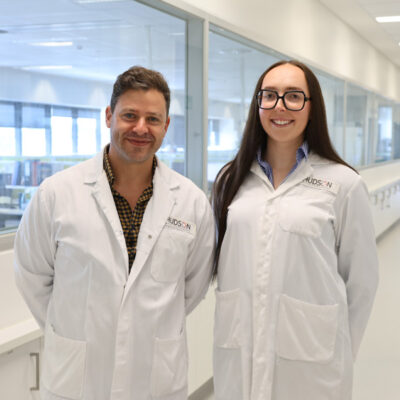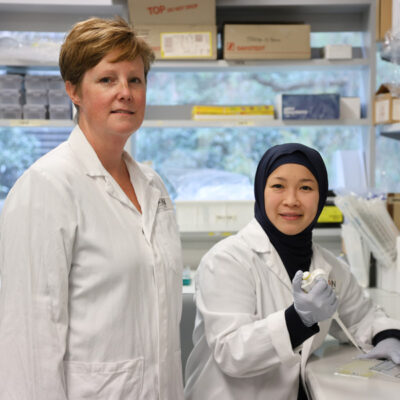Promising cerebral palsy treatment
By Hudson Institute communications
Every 15 hours, a baby is born with cerebral palsy – a condition that comes with life-long disability and has no cure.

While several studies globally have shown that umbilical cord blood (UCB) cells, a rich source of stem cells, are a promising treatment for cerebral palsy, the long-term outlook for the treatment is unclear.
In a study to assess the long-term outcomes of UCB treatment, Dr Courtney McDonald and PhD student, Tayla Penny, have filled in a major piece of the puzzle, showing that a single treatment improves long-term behavioural outcomes, but does not protect the brain from physical injury.
While there were no beneficial changes to the brain from the therapy, the clearly positive behavioural changes give hope that this treatment can be modified to help newborns at risk of cerebral palsy.
“In this case, it’s a bit like eating one apple a day – it’s not going to keep the doctor away. While a single dose of stem cells may not be effective in the long-term, multiple doses over a period of time could protect the brain from long-term damage,” Dr McDonald said.
The study will contribute to the future use of stem cells in an upcoming trial, where the effectiveness of stem cells in newborns will be explored further.
Benefits of umbilical cord blood cells
Stem cells can be easily harvested from UCB, then delivered to newborns within the first day of life. The abundance and ease of administration makes stem cells from the umbilical cord a potential treatment for neonatal brain injury, as the cells can promote repair to the damaged area.
Impacts of brain injury during birth
- In Australia, there are about 34,000 people with cerebral palsy (CP). Globally, this number reaches 17 million.
- Every 15 hours, an infant in Australia is born with a brain injury that underlines CP, making it the most prevalent congenital neurological disorder in our population.
- CP costs Australia more than $1.5 billion per annum.
What is cerebral palsy?
Cerebral palsy is an umbrella term that refers to the motor and postural impairments associated with damage to the developing brain. Cerebral palsy can result from injury sustained in utero, at or around the time of birth, or up until one month of age. These times correlate with critical periods of brain development and, when disrupted, this can lead to damage.
It is the most common disability in childhood. While the causes of brain injury can vary, we know that loss of blood and oxygen (known as hypoxia ischemia) to the brain during development can have devastating effects. While hypothermia, the only current therapy, can be given to some of these babies, nearly 50 per cent of these treated babies still develop severe neurological impairments. There remains a real need to develop more effective therapies to help these vulnerable babies.
Children with cerebral palsy not only have difficulty with movement, but also experience a range of other impairments, including difficulty talking, or with vision, sleeping and behaviour.
Collaborators | Monash Health, Monash University, University of New South Wales
Funders | Inner Wheel Australia
Contact us
Hudson Institute communications
t: + 61 3 8572 2697
e: communications@hudson.org.au
About Hudson Institute
Hudson Institute’ s research programs deliver in three areas of medical need – inflammation, cancer, women’s and newborn health. More
Hudson News
Get the inside view on discoveries and patient stories
“Thank you Hudson Institute researchers. Your work brings such hope to all women with ovarian cancer knowing that potentially women in the future won't have to go through what we have!”






